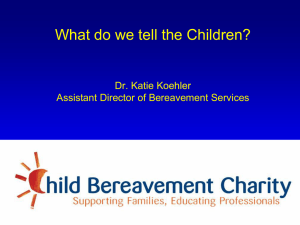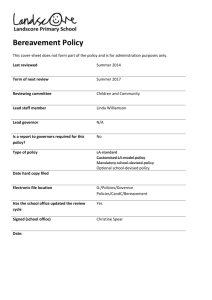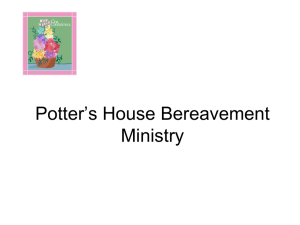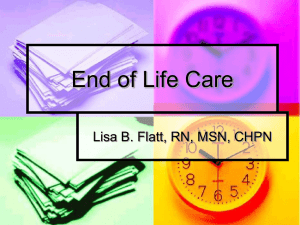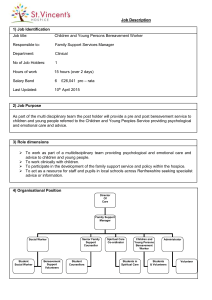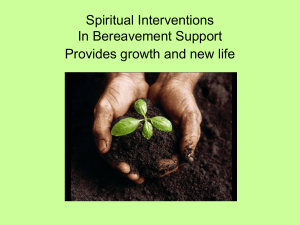1 - TARA - Trinity College Dublin
advertisement
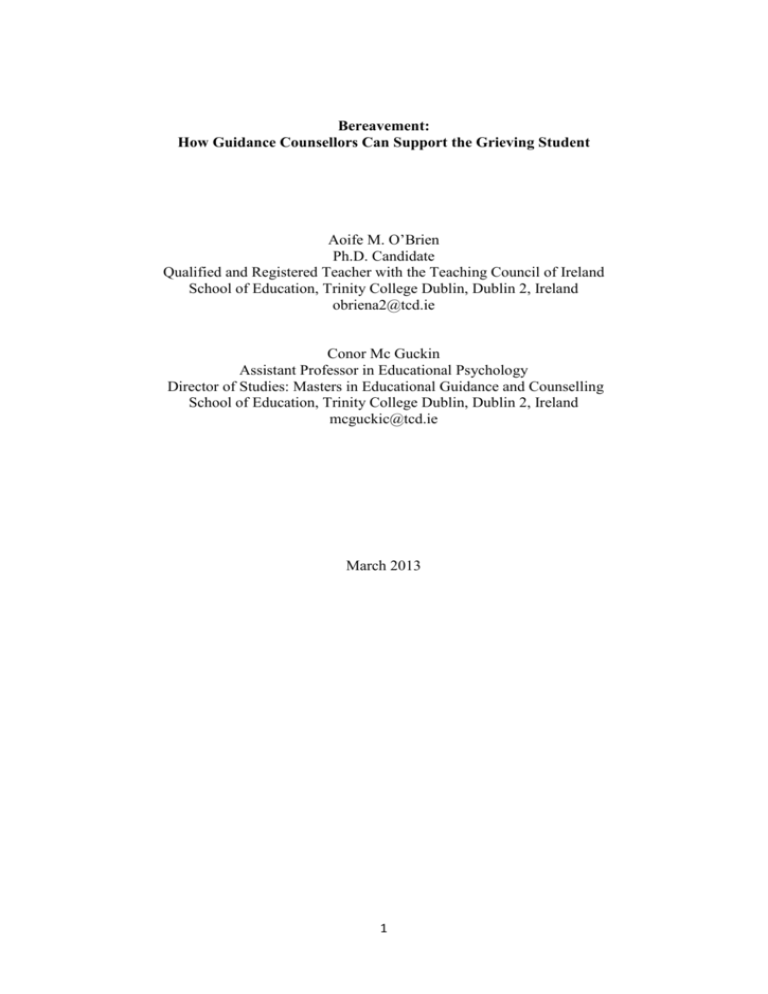
Bereavement: How Guidance Counsellors Can Support the Grieving Student Aoife M. O’Brien Ph.D. Candidate Qualified and Registered Teacher with the Teaching Council of Ireland School of Education, Trinity College Dublin, Dublin 2, Ireland obriena2@tcd.ie Conor Mc Guckin Assistant Professor in Educational Psychology Director of Studies: Masters in Educational Guidance and Counselling School of Education, Trinity College Dublin, Dublin 2, Ireland mcguckic@tcd.ie March 2013 1 Contents Summary ................................................................................................................................................. 3 Key Words .............................................................................................................................................. 3 Introduction ............................................................................................................................................. 4 Background ............................................................................................................................................. 4 Exploring the Language of Bereavement................................................................................................ 5 Theories of Bereavement and Grief ........................................................................................................ 6 Research Exploring Bereavement and Grief ........................................................................................... 8 Policy and Support Documents ............................................................................................................... 9 Conclusion ............................................................................................................................................ 10 Biography of Authors ........................................................................................................................... 16 References ............................................................................................................................................. 17 2 Summary Death is inevitable and universal, therefore, it is necessary for anyone who works with students to be prepared to offer help to those who experience bereavement naturally, suddenly, or traumatically. Indeed, help is sometimes required in advance of bereavement, in that a student may be ‘anticipating’ the death of a significant person in their life (e.g., parent in hospice care). It is estimated that between 36,000 and 60,000 young people in Ireland have experienced a significant bereavement (McLoughlin, 2012). As the role of the Guidance Counsellor is pivotal in supporting students who have been bereaved, as well as their peers and the rest of the school community, this chapter provides a review of the salient information that is useful to a Guidance Counsellor in their planning to provide immediate and on-going support. The chapter begins with a discussion of the definitional differences between types of bereavement and followed by an overview of the theoretical foundations of bereavement and grief, showing how the topic has altered over time, reflecting societal changes. Subsequently, attention is directed towards a review of research that has explored the nature, incidence, and correlates of bereavement among students. Critical to the work of the school-based Guidance Counsellor is the policy framework that guides their work. The chapter overviews policy documentation that is useful in planning for bereavement provision and support services for students. To conclude, attention is directed towards curricula materials, programmes and resources that are available to help Guidance Counsellors in this important work. Key Words Guidance Counsellor; bereavement; grief; schools; students; support. 3 Introduction With advancements in technology and modernity in general, children of today live lives that are fast and furious. However, despite the continual advances made by this ‘always on’ (Belsey, 2004) generation, there is one aspect of their lives that does not advance at any faster a pace than when we were children ourselves - emotional regulation. If we seek a brave new world for these brave new children we also need to provide help and support for the trials and tribulations of their lives. One notable experience that has the potential to have long-lasting educational, psychological, and health effects is that of bereavement. Bereavement, whilst preordained and universal, can have a combination of positive and negative consequences for young people. Grief generally follows bereavement; grief being a normal, healthy, and appropriate response to loss. Many people associate grief with a loss through death, but grief can be experienced after any personally significant loss, such as: separation; divorce; geographical relocation; the loss of a friendship through bullying; the loss of a job; or the failure to achieve a goal. Students are not immune to loss, or indeed the grief that follows it. The effect that death or a painful loss can have on a student can be as varied as the many forms of loss that can occur. Grief management and support, if it is to be effective, cannot be separated from the academic components of the curriculum, nor can it be dissociated from the school community at large. What students need most at such times is to be in a supportive, caring, and helpful environment. The role and influence of the Guidance Counsellor at these times cannot be underestimated. This chapter is aimed at providing Guidance Counsellors and educators with the requisite background knowledge of the area and a review of resources useful to support students who have experienced bereavement (or may be about to experience a bereavement). The understanding of bereavement in the chapter will be in its broadest terms, encompassing the various forms of aforementioned loss. While the chapter is aimed primarily at Guidance Counsellors, the information and recommended resources will be of use to anyone who has a responsibility (or interest) in supporting students in their care. Background Bereavement has the potential to affect the educational attainment and the physical and emotional health of the bereft; the work life of staff; and the community perception of schools as supportive educational and psychosocial environments. Students who have experienced the bereavement of a significant relationship or aspiration will react differently depending, for example, on their developmental stage (Mallon, 2011), level of family support (Harrington & Harrison, 1999), and socio-economic background (Humphreys, McCafferty, & Higgins, 2010). Common reactions to loss which may affect students include: An increase in daily fears; Regression in age appropriate behaviour; A decline in academic performance; Eating disorders; Substance abuse; Disturbing memories or flashbacks; Psychosomatic complaints; Social withdrawal. (Capewell, 1999; Sheras, 2000) 4 As students spend a great deal of their time in school, the reactions of educators is significant - as is the role that the school exhibits in ensuring that the needs of those who are bereaved are recognised and responded to in an appropriate manner (Cranwell, 2007). Adequate and appropriate support for bereft students has the very real potential to alleviate any potentially negative educational and health related outcomes in the future. However, this is not to say that all students who have experienced bereavement will need help, or that their grief should be pathologised. What is necessary, however, is that Guidance Counsellors and educators have the knowledge, skills, and resources necessary to support these students. In providing help to students, whilst personal experience and intuition are important, there are major limitations if relying on these personal factors. For example, personal experience of bereavement may be limited, or intuition may be coloured by subjective values, beliefs, and prejudices (e.g., cultural, religious). Also, the professional may not have fully recovered from a previous personal bereavement (either consciously or sub-consciously) and may become re-traumatised when having to consider how best to provide support to a student dealing with bereavement or grief issues. For example, in their recent research exploring the knowledge, attitudes, and perceptions of student teachers regarding disablist bullying, Purdy and Mc Guckin (2011) found that, despite the support of colleagues, their initial teacher education studies, and school policies, one-third of the student teachers reported that they would revert to ‘natural instinct’ (i.e., relying upon natural impulses rather than reverting to school policy, learning from Initial Teacher Education, support from colleagues etc.) when dealing with such issues. Guidance Counsellors have a central role in the task of supporting young people. Similarly to other issues that confront young people at school, a concern for many educators is whether or not they have the skills or resources necessary to work with students who are grieving (Burns, 2010). With this in mind, the chapter will equip readers with the salient background knowledge regarding bereavement and grief whilst providing practical resources and suggested readings, strategies, and points of contact to aid in the support of those who have experienced bereavement and require help. The chapter: Reviews the terminology and language of bereavement and loss; Explores theories that inform our understanding of bereavement and grief; Outlines what we have learned from research regarding the short- and long-term effects on young people who experience bereavement; Details the policies applicable to schools in Ireland; Reviews useful resources and activities. Exploring the Language of Bereavement The field of thanatology (the academic study of death) has been richly informed by researchers and practitioners from many disciplines. Therefore, the intricacies of bereavement and grief are mirrored by the myriad of definitions accompanying them. Bereavement itself refers to the status of the individual who has suffered a loss, and who may be experiencing psychological, social, and / or physical stress because a meaningful relationship has ended (Kastenbaum, 1997). There are three elements viewed as essential in defining bereavement (Corr, Nabe, & Corr, 2000): 1. That it includes a relationship with a person or thing that is valued; 2. That there is a loss of that relationship; 3. That a survivor is deprived by the loss. 5 For the purpose of this chapter, bereavement is considered to encompass the many forms of loss which result in a survivor being deprived of a relationship with a person or thing that is valued (e.g., pet, friendship, sibling, parent). Grief generally follows bereavement and can be a social as well as an individual process; therefore families, educators, and others in social groups may facilitate or hinder the grieving process (Maddison & Walker, 1967). There are many different forms of grief (e.g., anticipatory grief, acute grief, normal grief, complicated grief). One form of note for educators is that of ‘anticipatory’ grief; the process by which friends and family come to terms with the impending loss of a significant person (Casarett, Kutner, & Abrahm, 2001). Anticipatory grief is a multifaceted process which may consist of anger, guilt, anxiety, irritability, sadness, feelings of loss, and decreased ability to perform habitual tasks. Take, for example, the case whereby a student is anticipating the death of a parent who is receiving palliative care in a hospice environment. Whilst the parent is still alive, much positive work can be done to help the student, especially with the support and guidance with of a Medical Social Worker from the hospice. The impact of the bereavement can be significantly influenced at this preparatory stage. The essence is to understand that the student may have begun the grieving process prior to the bereavement. Due to the complexity and intangibility of the concept of grief, there have been various schools of thought surrounding the concept. Many questions still remain unresolved, such as: how do we differentiate between normal, abnormal, or pathological patterns of grief, considering that the grieving process is intrinsically individual and emotional responses can vary from instant to instant and person to person? Grief is thus a complex process with diverse consequences. For the purpose of this chapter, grief will refer to the complex amalgam of painful responses to bereavement, which may include sadness, anger, helplessness, guilt, and despair (Raphael, 1998). Thus, bereavement is the loss of a relationship with a person or thing that is valued; whereas grief refers to the psychological and physical responses resulting from the loss. Theories of Bereavement and Grief The theoretical foundations of bereavement and grief are essential in helping us to understand the reactions and symptomatology that may manifest in educational, psychological, physical, emotional, and social outcomes. These theories also provide explanations and indicate the stages of reactions that those who have experienced bereavement may encounter. A rudimentary knowledge of these theoretical perspectives is useful in aiding the Guidance Counsellor or educator when supporting those who have experienced bereavement and may be working through the grieving process. There have been many developments in our knowledge and understanding of loss and bereavement since the early theoretical foundations provided by Freud (1917) and Bowlby (1969). Their influential contributions have paved the way for subsequent theoretical and research developments regarding the effects of loss through death. As such, their theories permeated the scientific study of grief in the 20th Century and still continue to do so with great influence. Freud (1917) pioneered the study of the response to bereavement viewing grief as an isolated process whereby the bereft individual had to withdraw from the world in order to detach from the deceased. This ‘detaching’ would involve ‘working through’ the grief so that the loss could be overcome and the bonds severed. Freud considered that grief is part of a reconstruction process – a view supported by Parkes (1988) who introduced the concept of an ‘Assumptive World’. This incorporates the perception that we live in a world where we 6 assume that life will continue on as it always has; when a bereavement occurs, our assumptive world is shattered and we are forced to reconstruct a new world. Where the bereavement is traumatic, the assumptive world can be utterly shattered (Trickey, 2005), and therefore, more difficult to reconstruct. An important underpinning to our knowledge of bereavement and grief is derived from Bowlby’s (1969) Attachment Theory. According to Attachment Theory, children develop an attachment bond with their primary caregivers, despite individual differences in the quality of the attachment (Cassidy, 1999). This attachment, whether ‘secure’, ‘avoidant’, or ‘ambivalent’ is critical to the future development of young people. Through his work with Ainsworth, Bowlby (1951) recognised that in order to understand a person’s behaviour, it is also important to understand their environment (see Mc Guckin & Minton, forthcoming, for an understanding of ecological models). Bowlby, Ainsworth, and Main examined the way in which young children responded to the temporary or permanent loss of a mother-figure. Bowlby (1980) suggested that grief is the universally instinctive response to bereavement and from his observations he developed a new paradigm of understanding attachment and the impact upon the person when these bonds are broken. In particular, Bowlby found that when a parent’s behaviour changes following bereavement, problems may arise for the young person. Extending the seminal work of Freud and Bowlby, others (e.g., Kübler-Ross, Parkes, Worden) have provided us with various models and insights into the grieving process. For example, there are competing views which do not necessarily involve the breaking of bonds between the bereft and the deceased (e.g., Klass, Silverman, & Nickman; Stroebe & Schut), many of which involve stage (or phase) models. Stage theories are based on the notion that development in particular domains is through a sequential series of stages of growth and development (e.g., Freud and psychosexual development; Erikson and psychosocial development; Piaget and cognitive development). Whilst theoretically parsimonious and elegant, the inherent flaw with such stage theories is that they do not allow for idiosyncratic development, or that some individuals may not complete the stages in the way proposed by the theory. Despite these issues, the confident Guidance Counsellor can view the theories as thinking tools – tools that can be used either in isolation or conjointly to help provide a richer and deeper understanding of the particular case of bereavement and grief that they are providing support in relation to. Guidance Counsellors should feel confident and competent to engage with theories and their propositions, seeing them not as relics of days gone, but as guiding frameworks for the complexity of their everyday work. Perhaps one of the most widely known and understood stage models of how we understand the issues of bereavement and grief is that of Kübler-Ross (1969). Whilst the model was developed through her work with dying patients grieving for the loss of their future, the original conceptualisation of the stages have been more often applied to bereavement. The stages are: 1. 2. 3. 4. 5. Denial; Anger; Bargaining; Depression; Acceptance. Whilst the model presented is linear and sees the bereft individual working through the stages in a sequential manner, it is possible (and should be encouraged) to see the model in a more flexible manner. For example, some may experience Anger before Denial, some may not 7 experience Depression, and so on. Again, the richness of the theory is in how it can be used to guide thought and practice. In contrast to the stage model approach, the Theory of Continuing Bonds (Klass, Silverman, & Nickman, 1996) acknowledges that the bereft individual continues to preserve links with the deceased over time. Similarly, the Dual Process Model (Stroebe & Schut, 1999) emphasises how individuals may move between ‘Loss-orientated’ behaviour (e.g., grief, breaking of bonds, focusing on the past) and ‘Restorative-orientated’ behaviour (e.g., avoiding grief, focusing on the future) throughout the grieving period. Overall, it is evident that most models of grief suggest that the bereft need to engage with their loss and work through it so that their world can be reconstructed and reordered to become meaningful once again. It is important to remember that each bereaved person is unique and will deal with a significant loss and the subsequent grief in a different way. There is no right or wrong way to grieve. The challenge facing Guidance Counsellors is to discover how best to help the bereft student by finding out what helps them most. No single model of bereavement or grief is recommended above any others, as all have various components that may be useful. An important aspect of the Guidance Counsellor’s role is to listen and provide support while remaining vigilant for cases which may require additional support from allied professionals (e.g., National Educational Psychological Service, General Practitioner). Research Exploring Bereavement and Grief Loss is universal. While the experience of bereavement and grief remains uniquely personal, the goal of research is to explore and understand the nature, incidence, correlates, and most appropriate approaches to intervention and support (Collins, Mc Aleavy, Mc Guckin, Strain, & Mc Ilroy, 2002). Silverman (2000) argues that the work of the researcher and the work of the practitioner are two cultures that cannot exist without one another – especially within the realm of bereavement and grief. Thus, the central question for researchers and practitioners is: “Who grieves, how do they grieve, and what is the educational, psychological, and physical cost of the grieving process?” From a researcher-practitioner stance, whilst research aids our understanding and explanation of such processes, inevitably it is the front-line professionals - such as Guidance Counsellors - that must verify these findings from researchers. Whilst the effect of bereavement on adults is relatively well understood, the same cannot be said in relation to children and adolescents, where the impact of bereavement is relatively inconclusive (Christ, Siegel, & Christ, 2002; McLoughlin, 2012). However, much research indicates that young adolescents are likely to have problems adjusting to bereavement (Elizur & Kaffman, 1983; Fristad, Jedel, Weller, & Weller, 1993). The loss of a parent presents one of the more significant examples of personal loss, with potential impairment of the young person’s future development (Black & Young, 1995; Dowdney, 1999; Weller, Weller, Fristad, & Bowes, 1991). It has been estimated that 50 per cent of students who have a parent die are likely to be markedly hindered in their everyday functioning during the first year, with one in five requiring referral to specialist services (Black, 1996). Similarly, the important Harvard Bereavement Study (Worden & Silverman, 1996) found that bereaved students showed negative consequences (e.g., significant or sudden changes in behaviour, aggression, persistent anxiety) at one year (19%) and at two years (21%). Sweeting, West, and Richards (1998) found that, among a sample of females who had experienced the death of a parent (N = 1,000), 40 per cent had become pregnant before the age of 18. While the psychological pain and processes of grief are typically unavoidable, it is clear that the behaviour of adults relating to students day-by-day is a major contributory 8 factor towards a ‘healthy progression’ through grief (Cranwell, 2007; Dowling, Kiernan, & Guerin, 2007). Research exploring young people’s reactions to loss and traumatic events suggests that preventative support can help avoid long-lasting harmful effects (Sutcliffe, Tufnell, & Cornish, 1998). Interestingly, a US study found that following thirty years of teaching about death and bereavement in schools, those receiving death education had less fear of change and loss, better communication within their families, and had achieved better results than expected in other subjects (Stevenson, 2004). Within Ireland, McGovern and Barry’s (2010) research has shown that there is a need to take account of the fact that teachers and parents (especially men), whilst positive towards and supportive of death education for students, feel uncomfortable talking to young people about death. In comparing child bereavement and loss responses and needs of schools in Hull (UK) and Derry (NI), Tracey and Holland (2008) reported that training for teachers, pupils, and parents could help to develop a deeper understanding of the effects of bereavement, thus allowing educators to respond appropriately. Similarly, Shipman, Kraus, and Monroe’s (2001) UK research into competences and capabilities found that 56% of teachers felt inadequate in handling students who had been bereaved. Holland (2007) found that 58% of schools continued to report, over a ten year period, that more training was needed in the area of bereavement. While there are many organisations in Ireland that can provide support, these are predominantly aimed at adults; where support is offered to young people, it is often through trained volunteers rather than professional therapists (Dowling et al., 2007). Carroll (2010) outlined the need for services to demonstrate greater flexibility, more inter-agency working, and greater awareness within communities about the impact bereavement can have on children and young people and how they can be supported in the future. Headstrong’s ‘My World Survey’ (Dooley & Fitzgerald, 2012) reported that ‘One Good Adult’ is important for the mental well-being of students, with 25 per cent of 12 – 19 year olds students that they would seek information from a teacher or Guidance Counsellor in relation to their mental health. In considering the outcomes from research in this area, a central message for Guidance Counsellors is that whilst some students may not experience negative effects following their experience of bereavement, the critical volume of findings points to the immediate and future effects related to educational attainment, behavioural adjustment, emotional regression, and physical and psychological well-being. Considering these wide ranging effects, Guidance Counsellors should seek to incorporate the issue of bereavement in the Whole School Guidance Plan so as to enable the issue to be understood and positively addressed by all in the school community. Policy and Support Documents Regardless of the approach taken by a school in terms of having a bespoke Bereavement Policy, as a leader in the school community, the Guidance Counsellor, through their Whole School Guidance Plan, should seek to include provision for the support of the school community in relation to bereavement and grief. In terms of formalising a plan regarding support related to bereavement and grief in the school community, Guidance Counsellors can draw upon DES documents relating to the support and care of students. This is important considering McGovern and Tracey’s (2010) findings that a number of primary schools in Galway and Derry did not have a bereavement policy in place or had not addressed loss in their policy documents (83% and 35% respectively) and needed help to develop a bereavement policy. The Education Act (Government of Ireland, 1998) states that schools should include psychological services and Guidance and Counselling Services (Section 2b, c), to ensure that 9 there are support services made available to each student to meet their needs (Section 7), and that the educational needs of all students are identified and provided for (Section 9). The Inspectorate’s (2005) ‘Guidelines for second-level schools on the implications of Section 9(c) of the Education Act (1998), relating to students’ access to appropriate guidance’ are a useful companion to interpreting and implementing Section 9(c) of the Act. The Social, Personal and Health Education (SPHE) curriculum is aimed at enabling students to develop skills for self-fulfilment, living in communities, promotion of self-esteem and self-confidence, enabling them to develop a framework for responsible decision-making, provide opportunities for reflection and discussion, and promote physical, mental and emotional health and well-being (SPHE Support Service, 2009). Within this, there are obvious opportunities to introduce the concepts of bereavement and grief with differentiated emphasis on issues pertaining to cultural and religious sensitivities. In their report on consultation regarding the SPHE curriculum framework for senior cycle, the National Council for Curriculum and Assessment (NCCA, 2006) reported that students wanted to understand the stages of bereavement and loss, including how they might support themselves and each other in times of bereavement and loss. In 2007, the DES published ‘Responding to critical incidents: Guidelines for schools’ and the accompanying ‘Responding to critical incidents: Resource materials for schools’, highlighting the importance of ensuring that an effective team is in place to deal with ‘traumatic’ bereavement following crises. As a leader and coordinator of a guidance service, Guidance Counsellors should remain cognisant of the need to risk assess each case of bereavement and liaise with professional colleagues with expert knowledge in particular areas of bereavement and grief management (e.g., National Educational Psychological Service). The counselling component of the Guidance Counsellors’ role has been recognised as a key part of the development of the student, in that it enables them to develop coping strategies to deal with stress, personal and social issues, and any challenges that may life present (DES, 2005). Often raised is the link between the counselling part of the role and the mental health issues encountered by the youth of today. Important new ‘Guidelines on mental health for post-primary schools’ are to be launched soon by the DES. Guidance Counsellors should also be aware of the recent addition of two new documents relating to counselling. The first of these is a document developed by the Committee of the Directors of Studies in Guidance Counselling (Counselling competencies for guidance counselling education programmes: interim guidelines [2011]). Whilst the guidelines were drafted mainly to assist the programme providers regarding the counselling dimension of education and training programmes for Guidance Counsellors, they also provide a reference point for practitioners. The second document is the ‘Research on the practice of counselling by guidance counsellors in post-primary schools’ by Hayes and Morgan (2011). This research report is also a useful reference document in relation to the organisation and consideration of how Guidance Counsellors may plan effectively in relation to bereavement and grief support in the school community. Conclusion In a comprehensive review of the grief literature, Parkes (2002) outlined his vision for a future “… where parents as well as children, leaders as well as followers, receive the cherishing and support that they need; where the griefs that are a necessary part of life are recognised as such and those who suffer them receive understanding and wise counsel” (p. 383). Being guided by Parkes’ sagely advice, this chapter set out to provide Guidance Counsellors and educators with the salient information that is useful in informing practice 10 and the response to bereavement and grief within a school setting. The professionally qualified Guidance Counsellor should see the information presented in the chapter as a useful starting place from where to develop their understanding and confidence in this important area of student growth, learning, and development. To further aid this understanding, useful points of reference are presented below. 11 Useful Resources Barnardos Bereavement Counselling for Children A service for children and students who have lost someone close to them through death (e.g., a parent or a sibling). Barnardos work with families to help them support their child through the grieving process. Further information and guides can be found at: http://www.barnardos.ie/what-we-do/specialist-services/bereavement-counselling.html Bereavement Ireland The Bereavement Counselling Service (Registered Charity) was formed in 1982 by a group of professionals with backgrounds in psychiatry, medicine, social work, nursing and psychology. http://www.bereavementireland.com/ Children’s Grief Project The Children’s Grief Project is a Limerick-based support service for school-aged children and students affected by loss through death, separation or divorce. It provides a safe and supportive place for children and students and their families who are grieving. http://www.childrensgriefproject.ie/ Console Console is a National Organisation supporting people in Suicidal Crisis and those bereaved by suicide through professional counselling, support and helpline services. Console Service Centres are available in Dublin, Cork, Galway, Limerick, Athlone, Wexford, and Kildare. www.console.ie ChildLine A confidential telephone helpline service for children to use if they are worried about something. https://www.childline.ie/ 12 CRUSE Bereavement Care Bereavement care provided by trained counsellors in Northern Ireland, including advice and information on practical problems. http://www.crusebereavementcare.org.uk/ Daughters of Charity Child and Family Service The Daughters of Charity Child and Family Service, in partnership with the Health Services Executive Dublin North East, provide services to children, young people and their families. www.docharity.net Family Ministry ‘Seedlings’ is a 7 week grief support programme for young people who have suffered a bereavement of a significant person in their lives through death or separation. It is a peer support group facilitated by trained bereavement facilitators. Telephone: 021 4275136 Irish Childhood Bereavement Network The Irish Childhood Bereavement Network (ICBN) is a virtual hub for people working with bereaved children, students, and their families in Ireland. http://irishchildhoodbereavementnetwork.blogspot.ie/ Irish Hospice Foundation The Irish Hospice Foundation (IHF) is a national charity dedicated to all matters relating to dying, death, and bereavement in Ireland. In 2012, The Irish Childhood Bereavement Network and Europe’s first website dedicated to providing online training in bereavement support was established by IHF. The aim is to provide for those working with bereaved children, young people, and their families in Ireland by delivering education training courses and workshops for professionals, volunteers, and others with an interest in learning more about bereavement. www.hospice-foundation.ie 13 Living Links Living Links provides outreach, practical help, advice and support to those bereaved by suicide. Trained individuals are available to offer confidential, practical support and advice to families bereaved by suicide. http://www.livinglinks.ie/ Rainbows Ireland Rainbows (Registered Charity) is a peer-support programme to assist children and students experiencing a significant loss in their lives through a death, separation, or divorce in their family. Rainbows operates in sites such as schools, parishes, and community centres. The service does not offer professional counselling or therapy. http://www.rainbowsireland.com/ Samaritans Samaritans Ireland provides 24-hour emotional support to anyone experiencing distress, despair or suicidal thought. Tel: 1850-609090 (24 hours a day) Email: jo@samaritans.org Website: www.samaritans.org Support after Homicide This service offers emotional support and practical information for those bereaved by homicide, on a one-to-one basis in their home. Contact: 087-9837322 Teen-Line Ireland A confidential listening service for young adults from the age of 12 years. www.teenline.ie 14 Further Reading Books Authors A Student Dies, a School Mourns: Dealing with Death and Loss in the School Community. Ralph L. Klicker Books to Help Children Cope with Separation and Loss (Second Edition) Joanne Bernstein Children and Grief: When a Parent Dies J. W. Worden Helping Children to Cope with Separation and Loss. C. Jewett Someone To Talk To: A Handbook on Childhood Bereavement Pat Donnelly The Forgotten Mourners M. Pennells & S.C. Smith Understanding Children’s Experiences of Parental Bereavement John Holland When Kids Are Grieving: Addressing Grief and Loss in School. Donna M. Burns Working with Bereaved Children and Young People. Brenda Mallon 15 Biography of Authors Aoife Mary O’Brien Current position: Ph.D. Candidate, School of Education, Trinity College Dublin, Dublin 2, Ireland. Aoife Mary O’Brien is a qualified primary school teacher. Having received First Class Honours for her research into the area of bereavement, Aoife was awarded the Trinity Gold Medal. In 2012, Aoife was awarded a Scholarship from the School of Education to further her research exploring the role of educational professionals in alleviating the impact of child and adolescent bereavement in Ireland. Aoife’s research studies are mapping the knowledge and understanding of bereavement in Irish schools, retrospective accounts of bereavement from educators, and the development of curricular and CPD programmes and materials for use by, and with, educators and allied professions. Conor Mc Guckin Current position: Assistant Professor in Educational Psychology, Director of Studies: Masters in Educational Guidance and Counselling, School of Education, Trinity College Dublin, Dublin 2, Ireland. Conor Mc Guckin is a Chartered (British Psychological Society: CPsychol) and Registered (Psychological Society of Ireland: Reg. Psychol., Ps.S.I.) Psychologist, and is a Chartered Scientist (CSci) with The Science Council. Conor is the Director of Teaching and Learning (Postgraduate) in the School of Education at Trinity College Dublin. As part of the School’s Inclusion in Education and Society (IES) research grouping, Conor’s research interests relate to the areas of psychology applied to educational policy and processes, psychology of education, bully/victim problems among children and adults, special educational needs, psychometrics and testing, religiosity, and bereavement. 16 References Belsey, B. (2004). Cyber bullying: An emerging threat to the ‘always on’ generation. Retrieved from http://www.cyberbullying.ca/pdf/Cyberbullying_Article_by_Bill_Belsey.pdf Black, D. (1996). Childhood bereavement: Death and long term sequelae can be lessened by early intervention. British Medical Journal, 312, 1496. Black, D., & Young, B. (1995). Bereaved children: risk and preventative intervention. In: B. Raphael and G. Burrows (Eds.), Handbook of studies on preventative psychiatry. Amsterdam: Elsevier, pp. 225-244. Bowlby, J. (1980). Loss: sadness and depression (attachment and loss) (Vol. 3). New York, US: Basic Books. Bowlby, J. (1969). Attachment and loss: 1. Attachment. London, England: Hogwarth Press. Bowlby, J. (1951). Maternal care and mental health. Retrieved from http://whqlibdoc.who.int/monograph/WHO_MONO_2_(part1).pdf Burns, D. M. (2010). When kids are grieving: Addressing grief and loss in school. California, US: Corwin (Sage). Capewell, E. (1999). Disaster: How can schools respond? In: P. Barnard, I. Morland, & J. Nagy (Eds.). Children bereavement and trauma: Nurturing resilience. London: Jessica Kingsley Publishers, pp. 31-39. Carroll, B. (2010). Survey of childhood bereavement services in Ireland. (Unpublished Masters Thesis). Dublin, Ireland: Irish Hospice Foundation & the Royal College of Surgeons in Ireland. Casarett, D., Kutner, J. S., & Abrahm, J. (2001). Life after death: A practical approach to grief and bereavement. Ann Intern Med., 134, 208-215. Cassidy, J. (1999). The nature of the child’s ties. In J. Casssidy & R. R. Shaver (Eds.), Handbook of attachment theory and research. New York: Guilford Press, pp. 3-7. Christ, G. H., Siegel, L., & Christ, A. E. (2002). Adolescent grief: It really never hit me until it actually happened. Journal of Psychiatry, 34, 688-692 Collins, K., Mc Aleavy, G., Mc Guckin, C., Strain, M., & Mc Ilroy, D. (2002). Effectiveness of different forms of interventions in the schools and youth sectors: Literature. research report series No. 25. Bangor, Northern Ireland: Department of Education. Retrieved from http://www.deni.gov.uk/rb3_2002.pdf Committee of Directors of Studies in Guidance Counselling (2011). Counselling competencies for guidance counselling education programmes: Interim guidelines. Retrieved from http://www.ncge.ie/uploads/Counselling_Competences_Statement.pdf 17 Corr, C. A., Nabe, C. M., & Corr, D. M. (2000). Death and dying, life and living. Belmont, CA: Wadsworth. Cranwell, B. (2007). Bereaved children’s perspectives on what helps and hinders their grieving. Sheffield, England: Child Bereavement Charity Project & Sheffield Hallam University. Dooley, B., & Fitzgerald, A. (2012). My world survey: National study of youth mental health in Ireland. Dublin, Ireland: Headstrong & University College Dublin. Retrieved from http://www.headstrong.ie/sites/default/files/My%20World%20Survey%202012%20Online.p df Department of Education and Science (2007). Responding to critical incidents guidelines for schools. Retrieved from http://www.educatetogether.ie/wordpress/wpcontent/uploads/2010/02/responding_to_critical_incidents_-_guidelines_for_schools.pdf Department of Education and Science (2005). Guidance provision in second level schools. DES Circular PPT 12/05. Retrieved from http://www.education.ie/servlet/blobservlet/ppt12_05.doc Dowdney, L. (1999). Childhood bereavement following parental death. Journal of Child Psychology & Psychiatry, 7, 819-830 Dowling, M., Kiernan, G., & Guerin, S. (2007). Responding to the needs of children who have been bereaved: A focus on services in Ireland. The Irish Psychologist, 33, 261-262. Elizur, E., & Kaffman, N. (1983). Factors influencing the severity of childhood bereavement reactions. American Journal of Orthopsychiatry, 55, 668-78 Freud, S. (1917). ‘Mourning and Melancholia’ in The Standard Edition of the Complete Psychological Works of Sigmund Freud. London: The Hogarth Press. Fristad M. A., Jedel R, Weller R. A., Weller E. B. (1993). Psychosocial functioning in children after the death of a parent. Am J Psychiatry, 150, 511–513. Government of Ireland (1998). The Education Act 1998. Dublin: Stationery Office. Harrington, R., & Harrison, L. (1999). Unproven assumptions about the impact of bereavement on children. Journal of the Royal Society of Medicine, 92, 230-232. Hayes, C., & Morgan, M. (2011). Research on the Practice of Counselling by Guidance Counsellors in Post Primary Schools. Retrieved from http://www.ncge.ie/uploads/The_Practice_of_Counselling_by_Guidance_Counsellors_in_Pos t_Primary_Schools.pdf Humphreys, E., McCafferty, D., & Higgins, A. (2010). How are our kids? Limerick, Ireland: IKOS Research & Consultancy Ltd. with Mary Immaculate College. 18 Inspectorate (2005). Guidelines for second-level schools on the implications of Section 9(c) of the Education Act (1998), relating to students’ access to appropriate guidance. Retrieved from http://www.ncge.ie/uploads/pp_guidelines_second_level_schools_9c.pdf Kastenbaum, R. J. (1997). Death, society, and human experience (7th Ed.). New York: Merrill. Klass, D., Silverman, P. R., & Nickman, S. (Eds.) (1996). Continuing bonds: New understandings of grief. Washington DC: Taylor & Francis. Kübler-Ross, E. (1969). On death and dying. New York, United States: MacMillan Maddison, D., & Walker, W. L. (1967). Factors affecting the outcome of conjugal bereavement. The British Journal of Psychiatry 113, 1057-1067. doi: 10.1192/bjp.113.503.105744 Mallon, B. (2011). Working with bereaved children and young people. London, England: SAGE Publications Ltd. McGovern, M., & Barry, M. M. (2010). Death education: Knowledge, attitudes, and perspectives of Irish parents and teachers. Death Studies, 24, 325-333. McGovern, M., Tracey, A. (2010). A comparative examination of schools’ responses to bereavement and the associated needs of the school community in Galway, West of Ireland and Derry, Northern Ireland. Pastoral Care in Education, 28, 235-252. Mc Guckin, C., & Minton, S. (forthcoming). From theory to practice: Applying ecosystemic approaches to the understanding of school bullying. Australian Journal of Guidance and Counselling. McLoughlin, K. (2012). Establishing a children’s bereavement support network in Ireland: A scoping study. Dublin, Ireland: Irish Hospice Foundation. National Council for Curriculum and Assessment (NCCA) (2006). Social, Personal and Health Education Curriculum Framework for Senior Cycle: Report on Consultation. Retrieved from http://www.ncca.ie/en/Publications/Consultative_Documents/SPHE_Draft_Curriculum_Fram ework.pdf Parkes, C. M. (2002). Grief: Lessons from the past, visions for the future. Death Studies, 26, 367-385. Parkes, C. M. (1988). Bereavement as a psychosocial transition: processes of adaptation to change. Journal of Social Issues, 3, 53-65. Purdy, N., & Mc Guckin, C. (2011). Disablist bullying: An investigation of student teachers’ knowledge and confidence. A Report for the Standing Conference on Teacher Education North and South (SCOTENS). Report published by The Centre for Cross Border Studies for the Standing Conference on Teacher Education North and South (SCOTENS). Retrieved from http://scotens.org/docs/2011-disablist-bullying.pdf 19 Raphael, B. (1998). The anatomy of bereavement. New Jersey, USA: Aronson. Sheras, P. L. (2000). Grief and traumatic loss: What schools need to know and do. Washington D.C.: Hospice Foundation of America. Shipman, C., Kraus, F., & Monroe, B. (2001). Responding to the needs of schools in supporting bereaved children. Bereavement Care, 20, 6. Silverman, P. R. (2000). Never too young to know: Death in children’s lives. Oxford: Oxford University Press. Social Personal Health Education (SPHE) Support Service (2009). The aims of SPHE. Retrieved from www.sphe.ie/aims.aspx Stevenson, R. G. (2004). Where do we come from? Where do we go from here? Thirty years of death education in schools. Illness, Crisis and Loss, 12, 231-238. Stroebe, M. S., & Schut, H. (1999). The dual process model of coping with bereavement: rationale and description. Death Studies, 23, 197-224. Sutcliffe, P., Tufnell, G., & Cornish, U. (Eds.) (1998). Working with the dying and bereaved: systemic approaches to therapeutic work. Basingstoke: Macmillan. Sweeting, H., West, F., & Richards, M. (1998). Teenage family life, lifestyles and life chances: Associations with family structure, conflict with parents and joint family activity. International Journal of Law, Policy and the Family, 12, 1. Tracey, A., & Holland, J. (2008). A comparative study of the child bereavement and loss responses and needs of schools in Hull, Yorkshire and Derry/Londonderry, Northern Ireland. Pastoral Care in Education, 26, 253-266. Trickey, D. (2005). Young people bereaved by suicide: What hinders and what helps. Bereavement Care, 24, 11-14. Weller, E. B., Weller, R. A., Fristad, M. A., & Bowes, J. M. (1991). Depression in recently bereaved children. American Journal of Psychiatry, 148, 1536-1540. Worden, J. W., & Silverman, P. R. (1996). Parental death and the adjustment of school-age children. Omega, 33, 99-102. 20
